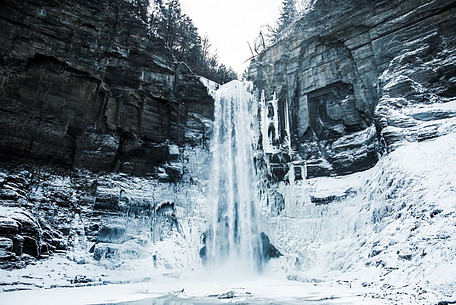
Water
Don’t be fooled, even in arctic regions, your body will need water. On average, you will need 1¾ pint (1 L) of water to replace daily losses. In summer, water is plentiful in tundra lakes and streams. Pond water may look brown and taste salty but vegetation growing in it will keep it fresh. BOIL water you have any doubts about.
In winter, melt ice and snow. Do NOT eat crushed ice as it can injure your mouth and lips causing further dehydration. Thaw snow to a point where it can be molded into a ball before trying to suck water from it. That being said, thoroughly melting ice will provide more water, per unit, than snow.
Remember: If you’re already cold and tired, eating snow will further chill your body.
Food
In the Antarctic, lichen and mosses, growing on sun warmed rocks on some northern coasts are the only plants. However, the seas are rich in plankton and krill that feed the fish, whales, seals and many seabirds. Most birds migrate in the autumn, however penguins will remain. As adorable as some folks may find them, they make good eating. Most of the time, they will take to the water if they detect danger. However, when incubating eggs, they will remain to defend their burrows or scrapes.
In the Arctic, the ice provides no habitat for plants or ground animals. Even polar bears are unlikely to be found, unless there are food sources nearby and they are difficult and dangerous to hunt. So, seabirds, fish and seals, which are to be found near water, are your best food sources. Foxes – the Arctic fox turns white in winter – will sometimes follow polar bears to scavenge their kills. If you follow them, you may be able to scavenge as well. Northern wildlife is migratory, so availability will depend on the season.
In Tundra and Forest, plants and animals can be found in the winter and summer and the northern forests contain more wildlife in general. Tundra plant species are the same in both Russia and Alaska. Of course, they are all smaller compared to their warmer-climate cousins. These plants, ground spreading willow, birch and berry plants with high vitamin content in addition to widely found lichens and mosses form a valuable food source, especially reindeer moss.
Poisonous Plants
The majority of Arctic plants are edible but AVOID the following:
- Water Hemlock – the most poisonous of this group
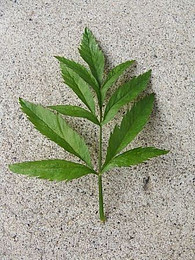
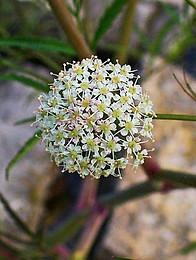
Water Hemlock Leaf Water Hemlock Flower
- Fruit of the Baneberry
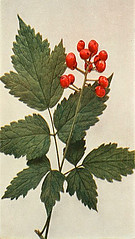
- Small Arctic Buttercups
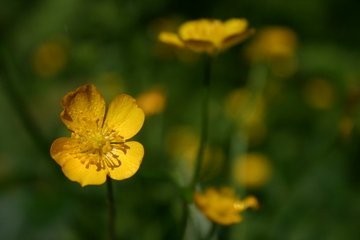
Other temperate poisonous species found in the north include:
- Lupin
- Monkshood
- Larkspur
- Vetch (locoweed)
- False Hellebore
- Death Camas
Best avoid fungi too – make certain that you can tell the difference between them and lichens! There are no known arctic plants that produce contact poisons.
Animals For Food
When you find bark and greenery stripped from trees, this is evidence there are feeding animals nearby. Caribou (a.k.a. Reindeer) are common from Alaska to Greenland. They are also found across northern Scandinavia and Siberia. Shaggy Musk-Ox roam in northern Greenland and Elk (Moose) are found in the Canadian archipelago islands. Both are generally found where there is a mixture of forest and open ground.
Wolves are common in northern Canada, Alaska and Siberia but are rare in European countries where they are protected by law. Foxes, white or otherwise, are living in the tundra in the summer and open woodland in the winter are indications of smaller prey, otherwise they wouldn’t be in the area. These smaller prey are usually mountain rabbits, squirrels and other smaller rodents that dig beneath the snow to find seeds. In addition, Lemmings, Beavers, Mink, Wolverines and Weasels can all be found in the Arctic.
Bears roam the barren lands of the north as well as the forests. They can be dangerous – give them a wide berth.
The best chances of survival are along the coasts where the sea provides an abundant and dependent supply of food. Seals are found along the coasts and pack ice in the open water.
Walruses may look large and clumsy but they are very dangerous. LEAVE THEM ALONE UNLESS YOU ARE ARMED!
Hunting & Trapping
Tracks in snow are clear and easy to follow. However, leave a trail of fluttering flags of bright material from wreckage to find your way back to your shelter. Make them high enough not to be covered by new fallen snow.
Caribou can be very curious and can sometimes be lured by waving a cloth and moving on all fours. However, be careful, because imitating a four-legged animal may also bring wolves closer, thinking you might be prey. Ground squirrels and marmots may run into you if you are in between them and their holes.
Some prey can be attracted by kissing the back of you hand, it sounds like the noise made by a wounded mouse or bird. Make it from a concealed position and downwind. You may have to be a little patient for something to hear the sound and respond – keep trying if nothing shows up immediately.
Stalking animals is difficult – to say the least – if exposed in the arctic. If you have a projectile weapon such as a bow or a gun that be fired from ground level, lie in ambush behind a snow screen. To be more mobile, make a screen of cloth that can stand in front of you – and be moved slowly forward.
In winter, owls, ravens and ptarmigans – the birds available in the north – are usually relatively “tame” and can be approached slowly, without sudden movements. Many polar birds have a 2-3 week summer molt which makes them flightless, and vulnerable – they can be run down. Eggs are among the safest foods and are edible at any stage of their embryonic development.
Seals
A primary source of arctic food – seals remain in the area throughout the entire year. Seals are the most vulnerable on ice floes with their young pups. Newborn seals can not swim and are easy to catch.
Out of the breeding season, breathing holes in the ice are the best place to catch seals. These holes are recognized by their cone shape – narrower on the upper surface. In thicker ice, they will be surrounded by flipper and tooth marks where the seal has been keeping the hole open. You need to be patient, but vigilant as the visits to the hole are brief. Club the animal then enlarge the hole to recover the carcass.
Some seals can remain under for 15 minutes before needing to come up for air but most need to breathe more frequently. However, be careful, because the Elephant seal can rear up to twice a man’s height in both attack or defense.
Bottom line is that seals provide food, clothing, moccasins and blubber for fires. Adult males have a strong odor early in the year, but it does not affect their meat. You can eat all except the liver, which at times has dangerous amounts of vitamin A. Cook seal meat to avoid Trichinosis (a parasitic disease caused by roundworms).
Preparing Meat
Ah, here you are. The most important part of this page – how to prepare your catch for eating. I doubt that anyone really wants to eat raw meat unless you have no other choice.
Bleed, gut and skin you catch while it is still warm. Roll the hides before it freezes. Cut meat into usable portions and let it freeze. Do not keep reheating – once the meat is cooked, eat any leftovers cold. Leave fat on all catches except seals. Fat is essential in cold areas but, if you eat a lot, make sure you drink plenty of fluids. Except in extreme cold, where it will freeze, remove seal fat and render it down before it turns rancid. It can also be used a fuel for your fire.
When food is scarce animals will steal it from you – so cache it carefully. If there are signs of would-be thieves, look out for them, they could be your next meal, lol! When I was camping with my friend in the Rockies, we made the mistake of leaving bacon grease out in the open. By the time we woke up, several animals had sampled the offering as evidenced by the claw marks. We don’t think it was well liked as there was still a lot left but we weren’t going to permit a second helping…
Be warned, rodents, like squirrels, rabbits and hares can carry tularemia, which can be caught from ticks or handling infected animals. Wear gloves when skinning – boiled flesh is safe.